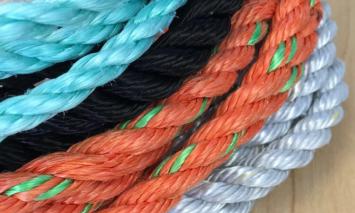
Whale Release Rope
In 2015, New England Aquarium researchers and collaborators published a paper in Conservation Biology titled Effects of fishing rope strength on the severity of large whale entanglements correlating rope strength with increased risk and severity of large whale entanglements (Knowlton et al. 2016). As a result of that study, the authors recommended that rope strengths of 1,700 pound-force (lbf) breaking strength or less, a.k.a. “Whale-Release Ropes” be used in fixed gear fisheries to reduce the incidence and injury severity of entanglements with large whales.
In June 2016, the Office of Energy and Environmental Affairs awarded a contract to researchers from the Anderson Cabot Center for Ocean Life at the New England Aquarium to carry out the following tasks:
- Collaborate with fishermen, polymer engineers, and rope manufacturers to develop a 1700 lbf breaking strength rope based on discussions with fishermen about their desired rope properties (stiffness, ease of coiling, durability, others).
- Work with three rope manufacturers to develop a total of six prototypes of reduced breaking strength ropes with better abrasion resistance, and possibly a better “whale avoidance” color scheme than ropes presently used for fishing.
- Lab test prototype ropes for abrasion resistance and breaking strength before and after abrasion testing.
- Work with Bellequant Engineering to simulate right whale entanglements in the existing Whale Simulator, in order to test interactions with ropes of various breaking strengths, and assess how different rope strengths will impact the entanglement configuration and severity.
- Work with lobster fishermen along the coast of Massachusetts to test these prototypes while they are actively fishing to assess how the ropes handle in comparison to standard ropes. All findings were shared with the Massachusetts Office of Energy and Environmental Affairs and NOAA Fisheries.
The most challenging aspect of this study was identifying manufacturers committed to producing prototypes according to specifications. Several ideas for prototype development were tried but the only successful option deemed to be suitable for testing at sea was the hollow braided Novabraid sleeve developed between several members of the South Shore Lobster Fishermen’s Association and rope manufacturer Novatec Braids Ltd.
During at-sea testing of the braided sleeve rope there did not appear to be an increased rate of breakage in endlines where sleeves were integrated as compared to the control endlines. In addition, at-sea use showed minimal loss of breaking strength and the potential for most sleeves to be used for multiple seasons. Some participating fishermen expressed concern about the time involved in integrating sleeves into the endlines, although with a small degree of practice it takes typically less than 5 minutes per sleeve. Encouragingly, the results of our study did not indicate that use of these ropes would lead to more gear loss.
Publications
Stiff Rope
The Consortium is testing whether ropes that have greater stiffness or fish under greater tension may be effective for reducing entanglements. The stiffness or tension would reduce the ability of the rope to bend, allowing animals to slide off any rope encountered. The Consortium is measuring rope tension under different environmental conditions and studying the fisheries that use tense rope to determine how effective it may be to reduce bycatch.
Publications
Publication Link
Baldwin, K., Byrne, J. and B. Brickett,2012 , Taut vertical line and North Atlantic right whale flipper interaction: Experimental observations, Final Report to the Consortium for Wildlife Bycatch Reduction, under NOAA Award# NA09NMF4520413 to the New England Aquarium, Boston. , ps 11
Red Rope
Scientists believe that vertical fishing lines pose a serious entanglement threat to whales. In 2012, New England Aquarium scientists tested whether whales could see and avoid different color vertical lines.
Media:
Maine Lobstermen's Community Alliance: finding ways to keep whales out of vertical lines
Changing lobster ropes' color could save whales
